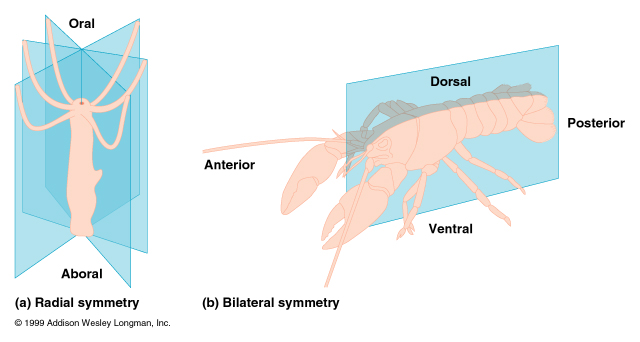
Radial versus Bilateral Symmetry
The
most ancient animal forms are characterized by radial
symmetry, in which there is no clear distinction between
any one plane section of the animal and another. Most of
these, like the hydra as shown, have oral and aboral
ends, that is, a mouth at one end and an excretory opening
at the other end. Radial symmetry also occurs in more
evolutionarily derived forms, such as Echinodermata
(sea urchins and starfish), which are most closely
related to Chordata.
Bilateral symmetry occurs in animals in which a single plane section divides the animals into "left" and "right" halves that are mirror images of each other. Typically, the left / right axis is oriented perpendicular to gravity, so that the animal also has a dorsal surface above and a ventral surface below [think of "v" as pointing down, and "d" as pointing up], as well as well-defined anterior (front) and posterior (back) ends.
Homework: Humans stand upright. What names are given to the dorsal and ventral surfaces, and to the anterior and posterior ends?
Bilateral symmetry occurs in animals in which a single plane section divides the animals into "left" and "right" halves that are mirror images of each other. Typically, the left / right axis is oriented perpendicular to gravity, so that the animal also has a dorsal surface above and a ventral surface below [think of "v" as pointing down, and "d" as pointing up], as well as well-defined anterior (front) and posterior (back) ends.
Homework: Humans stand upright. What names are given to the dorsal and ventral surfaces, and to the anterior and posterior ends?
Figure ©1999 Campbell et al.; text © 2019 by Steven M. Carr